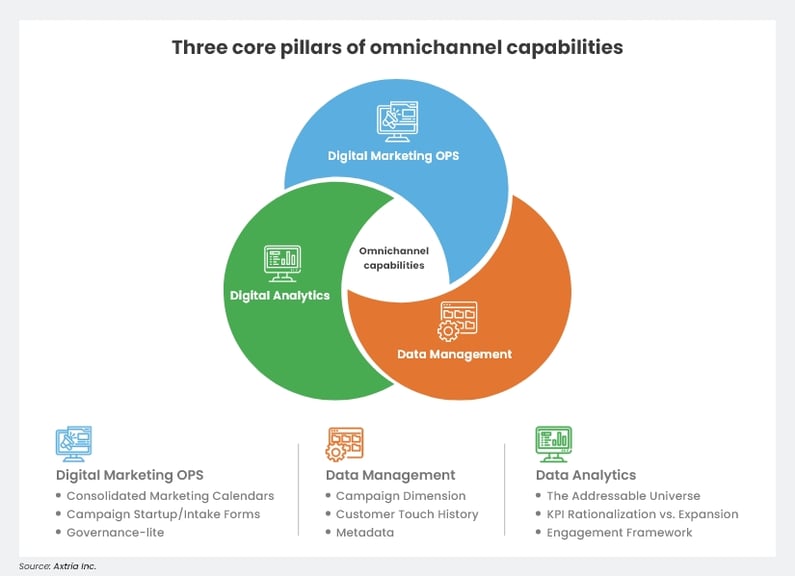The Fundamentals Matter - Foundational Priorities For Omnichannel Success
Introduction
Whether talking about investments, math, sports, or anything else of consequence, getting the fundamentals right is important. It helps you develop good habits, establishes muscle memory, and lays a foundation for more nuanced skills development. Strong fundamentals shorten your path to mastery. This is equally true for the systems and processes organizations need to operate effectively in digital marketing and omnichannel orchestration. While most life sciences organizations have made significant investments in digital marketing, very few have arrived at a practiced and efficient set of capabilities.
In this article, we'll cover three core pillars that support any organization’s omnichannel capabilities: Marketing Operations, Data Management, and Digital Analytics. These are interdependent. Your team’s analytics are only as good as the available data. And the usability of that data for insights is very much dependent on the rigor you have built into your campaign planning and tracking approaches.
Some fundamentals, such as automation, data quality checks, and governance, apply to any program with scaled analytics. We will describe some of the less obvious fundamentals that are specific to well-managed orchestration and measurement capabilities.

Digital Marketing Ops
Early-stage digital marketing capabilities often develop organically or get outsourced to agencies or vendors. While the capabilities are shown to work, without strong fundamentals, quality, automation, scale and cost efficiency all suffer.
What does every marketing operations group need in order to build a solid operations foundation?
Consolidated Marketing Calendars:
Every brand does some sort of planning for its marketing campaigns. While all of these should tie to strategic brand objectives and goals, the reality is that exactly how marketers go about transforming strategies into tactics and campaigns varies greatly. The process ranges from simple exercises that lay out discrete campaigns on a calendar to much more robust approaches that consider marketing mix or attribution analysis and advanced segmentation as critical inputs.
Whatever the complexity and nuance involved, life sciences organizations generally fail to take the next critical step to consolidate marketing calendars in a systematic fashion. Why is this fundamentally important? Ask any brand manager to list what campaigns were in-market during a specific month last year, and they’ll often not know. Their team may have done a great job planning and targeting the campaign, but it’s done, and they’ve all moved on. It becomes difficult to attribute top-line outcomes to specific interventions without a record of what was in-market and when it came to market.
Campaign Startup/Intake Forms:
Ensuring campaigns are initiated in a consistent manner is a critical driver of downstream data quality. There can be a lot of moving parts, but some elements are absolutely fundamental: keeping a record of the campaign dates, goals, and the tactics used is essential, as is tracking any click-through Uniform Resource Locators (URLs) and associated Urchin Tracking Module (UTM) parameters for tracking how well your campaigns are performing. Consistent use of a campaign intake form provides basic guardrails to your marketing operations. Make it a habit, and it will pay you dividends in the form of faster time to go live, fewer errors, and better campaign performance data.
Governance-lite:
It can be tempting to over-engineer processes to the point that they create more busy work than efficiencies. Governance might be the poster child for this phenomenon. Rather than slow things down and kill morale, consider a light governance model to start. Strategy and regulatory considerations aside, build your marketing or digital governance with an eye toward the speed of launch and ensuring quality data is coming back to the organization. The complexity of real-world governance will arrive soon enough. Keep a light hand in the early days, and you’ll get more buy-in from your organization.
Data Management
Rearchitecting a data platform when it is already being used by reporting systems and data science teams can be extremely costly. Nowhere is starting with the right foundation more critical than in data management. Users will have more trust and confidence in the data.
Beyond good data management practices, what should data management teams do to support digital marketing?
Campaign Dimension
Most companies already master “product” and “customer” in their data lakes. One key addition for a Marketing Data Hub is a well-defined campaign dimension. Treat campaign activity as you would any other dimension when you are thinking about how to store and analyze marketing data. Model it as a single source of truth and the historical record of promotional activity, where there is one record per discrete event. Then add all the attributes that describe that campaign, such as channel, vendor, start/end date, click-through URL, and so on. This is the place in your data ecosystem where the quality of marketing ops work directly impacts the ability of analytics teams to efficiently and effectively generate performance insights.
Customer Touch History
A holistic view of customer interactions is incredibly important, and it can be a real challenge given the overall fragmentation of digital data. After you have integrated activity data at the channel level, build a unified fact table that models every instance of promotion and response. Then, connect it to your conversion or sales data. If you arrive at a spot where you can quickly (<5 mins each) answer the following two simple questions, then you are in a position to do much, much more:
-
What digital promotions were sent to Dr. McIntyre between May 1, 2020 and October 31, 2021, and how did she respond?
-
How much site engagement are we driving with our display ads this year?
This simple data modeling exercise, done successfully, opens up a whole world of digital insights: rapid customer segmentation, customer engagement tracking, attribution analysis, campaign ROI, and more. Start early and add channels as you go.
Metadata
While the topic sounds fancy, it’s really just a table- or file-driven way to maintain order and transparency in your data processes. Books have been written about this, as there are many types of metadata. Three that are immediately relevant are logging, business rules, and data quality checks. Logging is the simplest of them all. For every important data operation, insert a record into your logging table or file that records things like which table is being updated, how many records are being added or deleted, a date stamp, etc. When a data job fails halfway through or a user says the data looks incomplete, you’ll have a strong starting point for evaluating if a problem exists and, if so, where to find it. Pro-tip: write a user-defined function or something similar that your developers can call from code to make it painless for them to follow this practice.
Similarly, we use metadata approaches in our extract, transform, and load to separate data movement code from business logic wherever possible. Instead of embedding key performance indicator (KPI) calculations in long and complex procedures, place them into metadata tables and call on them when needed to ensure the KPI gets calculated the same way everywhere and to centralize the often risky task of making changes to those same calculations. We use this same approach for things like data quality checks, setting upper and lower bounds to help assess data variations, and creating cleaner segment groups from messy lists of values in source data. The examples here could go on and on, but it really boils down to good housekeeping and cleaner code.
Digital Analytics
The Addressable Universe
While most marketers and analysts know the top-line number of healthcare practitioners (HCPs) in a given space, that consensus quickly disappears when you start asking questions. How many HCPs are there in this therapeutic area? How have we segmented them? How many are actually in our call plans versus digital only? Before diving into specific-channel or campaign performance analytics, do your stakeholders a favor by providing a level-set on the addressable universe. Create a one-pager that is always on and always up to date, and ensure it is part of your regular audience review cycles. How often this needs to happen depends on how stable or volatile your customer universe is. If you re-segment on a regular basis or are edging toward dynamic call plans, you may need to publish this information monthly. In other situations, you may need to publish less frequently. As new stakeholders join your organization, they’ll appreciate the baseline view of this. Take it a step further by applying this same kind of level-set to overall reach and response metrics.
KPI Rationalization vs. Expansion
When we “rationalize” something, we pare it down to its minimum elements and aim to retain only what is genuinely needed. A list of KPIs can grow too fast and too soon in digital marketing programs, creating complexity when the team is still trying to develop fundamental muscle memory. Consolidation and harmonization are the hallmarks of KPI rationalization. First, consolidate the organization’s understanding of channel and program performance around a small set of KPIs that you segment in simple and consistent ways. For example, display ads will only require spend, impressions, and click-through rate. Return on ad spend (ROAS) is obviously important, but it can be complicated to implement and explain unless the linkage to conversion is unambiguous. Viewability is another conversation altogether. Keep it simple and consolidate your KPIs in the early stages of your omnichannel program. The complexity will come soon enough, but try to fend off KPI expansion where possible.
When considering “harmonization,” social media is probably the easiest to conceptualize. A Facebook share, a Twitter repost, or an Instagram share should be treated the same. Unless otherwise needed, report on them as “Social Media” writ large rather than as separate channels. Similarly, many customers utilize email marketing, e-newsletters, and alerts, which are all really just emails. Again, treat these as one unified channel. In short, your reporting and analytics will be less burdened by complexity in those crucial early days if you can effectively rationalize your KPIs.
Engagement Framework
Years ago, a former colleague would often call engagement ”the great forgotten middle of the funnel.” That description stuck with me. Fortunately, engagement is no longer forgotten, as tons of companies have embraced the importance of driving and sustaining customer engagement as a core pillar of overall success. But defining engagement as one monolithic thing for the purposes of your analytics can feel awfully nebulous. Moreover, different brands and markets within the same company will have their own ideas about what constitutes engagement. These ideas are often a result of the local tools and tactics available. One doesn’t consider participation in lunch-and-learns as part of engagement if one isn’t running lunch-and-learn campaigns. In the spirit of KPI harmonization, then, define a simple scoring model of your own to track engagement. Within reason, let the brands or markets utilize their specific business rules for defining engagement, but ask them to fit those business rules into the rationalized framework. The organization then has a basis for analytics discussions around engagement without a monolithic definition of them.
Conclusion
This short paper on omnichannel fundamentals is not intended to be comprehensive. We’ve simply attempted to outline some of the top priorities for organizations seeking to build or refine their omnichannel capabilities. Many companies skip some of these steps, only to find that a significant amount of retrofitting or rebuilding is necessary later on. This rebuilding can be very costly in both time and dollars. Get the fundamentals right, and your organization will find omnichannel success much faster.
Author details

Philip Daniels
Philip Daniels is a Principal at Axtria. In his role, Phil is responsible for people management, assisting business development, providing input into Axtria’s delivery practice areas, and much more. He has 20 years of data warehousing, BI, and analytics experience in the life sciences and retail industries. He specializes in analytics strategy, engagement management, and platform architectures. His interests and skills include data visualization, educational performance data, organizational culture, systems integration and automation, architecture, and landscape architecture. He presented his thesis on Organizational Culture and Institutional Power – The Work of Michel Foucault. Phil is currently on the Board of Directors for the Norristown Area School District.




